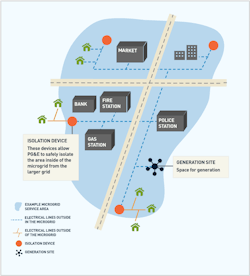California Utility regulators approve Community Microgrid expansion by PG&E
The California Public Utilities Commission has granted approval to Pacific Gas and Electric Company to update its Community Microgrid Enablement Tariff and expand the eligibility requirements for connecting microgrids to PG&E’s electric distribution infrastructure.
The approval means communities in PG&E’s service area will be able to pursue a microgrid as part of their energy resilience plans. Earlier, community microgrids were only allowed in CPUC-designated High Fire Threat Districts.
“Microgrids are a critical part of the sustainability and climate-resilience goals of many of our customers and hometowns," PG&E’s director of grid planning and innovation, Quinn Nakayama, said. "By expanding the rules around where these microgrids can be built, we’re able to remove barriers that would have prevented projects from moving forward, and instead work collaboratively to make these projects a reality.”
The expanded eligibility builds upon PG&E’s Community Microgrid Enablement Program, launched in April 2021 to support the development of microgrids centered around critical facilities in high-fire threat areas.
To date, PG&E has engaged with more than three dozen communities and customers to explore potential financial and infrastructure support options for developing microgrids and resilience solutions through the CMEP.
“We strongly support PG&E’s leadership around microgrids and the innovative ways they are meeting the needs of customers. More microgrids, whether they’re in Silicon Valley or the Central Valley, mean a more sustainable and resilient energy future for all. It is our hope that other utilities will follow PG&E’s lead and seek to partner with customers and communities to build the consumer-driven resilient grid of the future,” said Alexa Arena, senior director of large-scale developments at Google and a 2021 Silicon Valley Business Journal Woman of Influence.
PG&E is already working with the University of California, Berkeley on Oakland EcoBlock to demonstrate a net-zero energy, block-level microgrid. The work at EcoBlock will include implementing energy efficiency measures in participating homes, deploying a solar-powered microgrid and shared EVs and adopting a new approach to coordinating these resources.
About the Author
EnergyTech Staff
Rod Walton is head of content for EnergyTech.com. He has spent 17 years covering the energy industry as a newspaper and trade journalist.
Walton formerly was energy writer and business editor at the Tulsa World. Later, he spent six years covering the electricity power sector for Pennwell and Clarion Events. He joined Endeavor and EnergyTech in November 2021.
He can be reached at [email protected].
EnergyTech is focused on the mission critical and large-scale energy users and their sustainability and resiliency goals. These include the commercial and industrial sectors, as well as the military, universities, data centers and microgrids.
Many large-scale energy users such as Fortune 500 companies, and mission-critical users such as military bases, universities, healthcare facilities, public safety and data centers, shifting their energy priorities to reach net-zero carbon goals within the coming decades. These include plans for renewable energy power purchase agreements, but also on-site resiliency projects such as microgrids, combined heat and power, rooftop solar, energy storage, digitalization and building efficiency upgrades.
